This beach-inspired cake is decorated with graham cracker crumbs and a gelatin ocean!! It’s the ultimate summer cake!
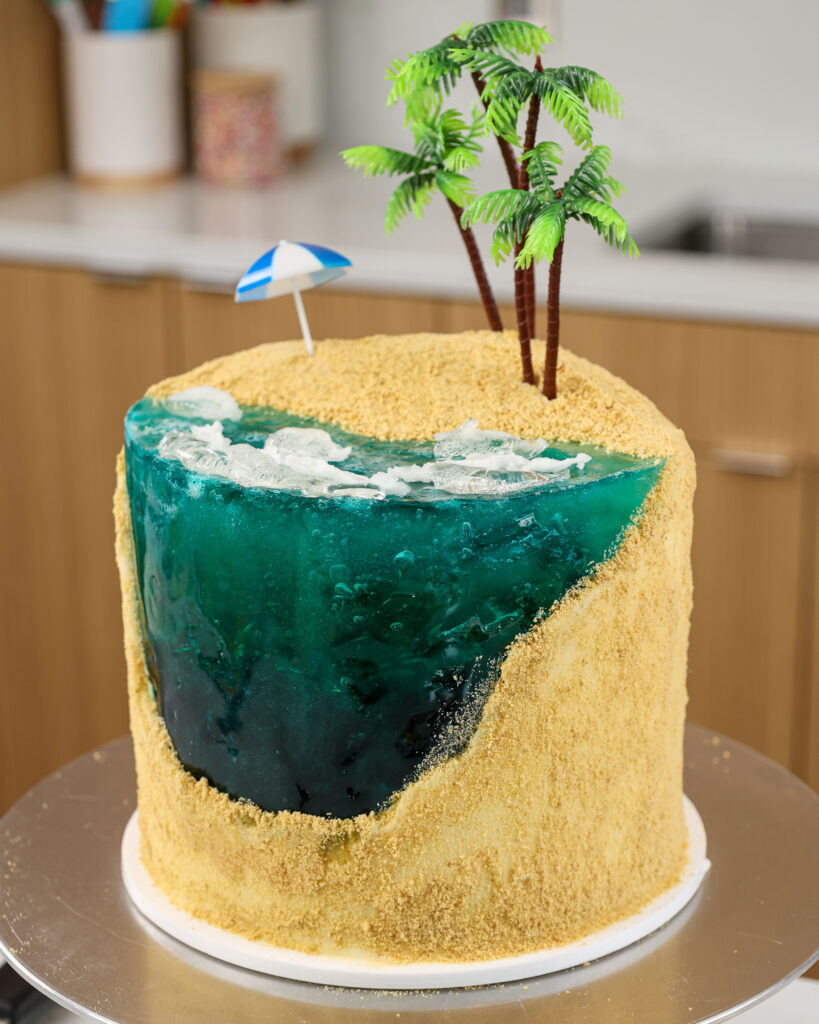
This cake is inspired by an incredible beach birthday cake made by @oh.honeycake. However, I simplified the design a bit to make it more approachable.
How to Make This Ocean Beach Cake
To make sure this cake turns out as amazing as possible, let’s walk through each step together!
I’ve also included a video tutorial of the process below.
Step 1: Make the Ocean Gradient Jello
The first step of this cake is to make the jello that will be used to make the gradient in the ocean! This will give the ocean a beautiful color and make it look just like a tropical beach.
After making the gelatin mixture, split the mixture between 2 shallow, wide bowls or cake pans and color one turquoise and one deep blue. Place these in the fridge to chill and set.
This usually takes about 2 hours but can vary based on the depth of the bowls you use.
It can also be made up to a week in advance. If making these further in advance, cover the bowls with plastic wrap.
Step 2: Make the Sand Colored Vanilla Cake Layers
Next, we make the vanilla cake layers. Preheat oven to 350°F / 175°C. Line four 7″ or three 8″ pans with parchment rounds, and grease with non-stick baking spray.
Divide the batter evenly between the prepared pans. I like to use a scale to make sure each pan has the same amount of batter and will bake up to be the same height.
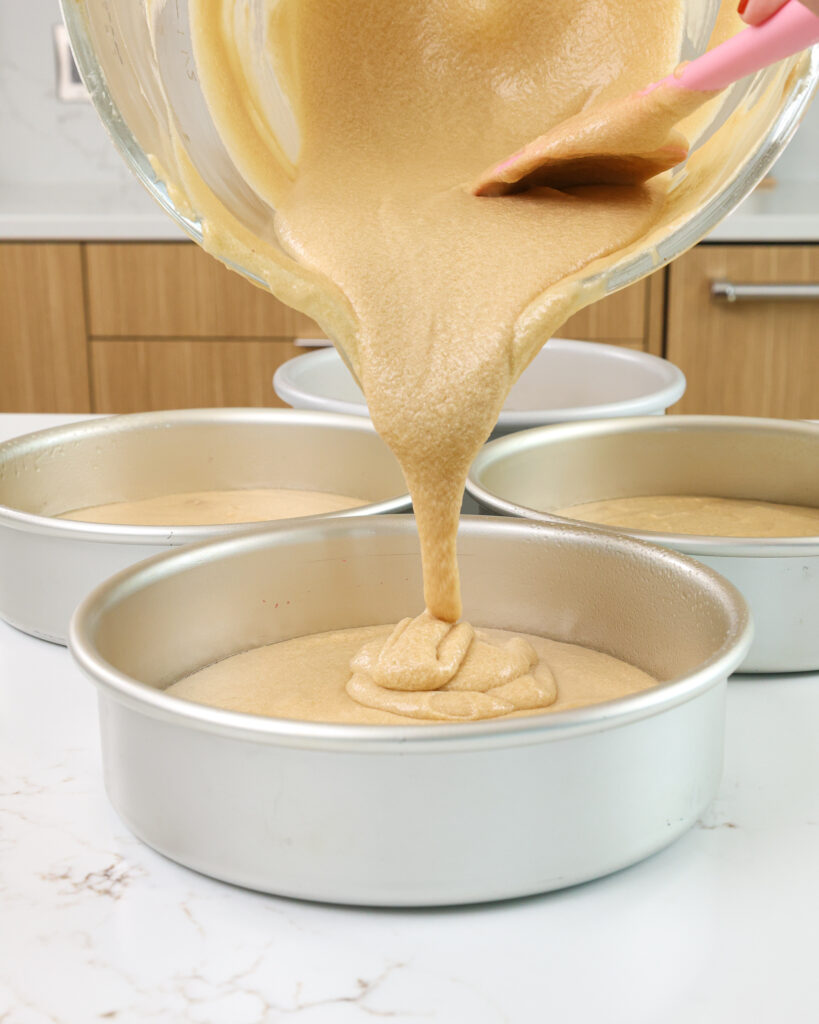
Bake for 33-35 minutes or until a toothpick comes out with a few moist crumbs.
Let the pans cool for 10 minutes, then run a small offset spatula around the perimeter of the pan to separate the cake from the pan.
Place the cake layers into the freezer for 30 minutes to accelerate the cooling process. Once the layers are fully cooled, carefully flip the pans and remove the layers.
Step 3: Level and Trim the Cake Layers
Use a serrated knife to level the tops of the layers.

Then stack the cake layers and cut them at an angle (see photo below). This will create space for the gelatin ocean!
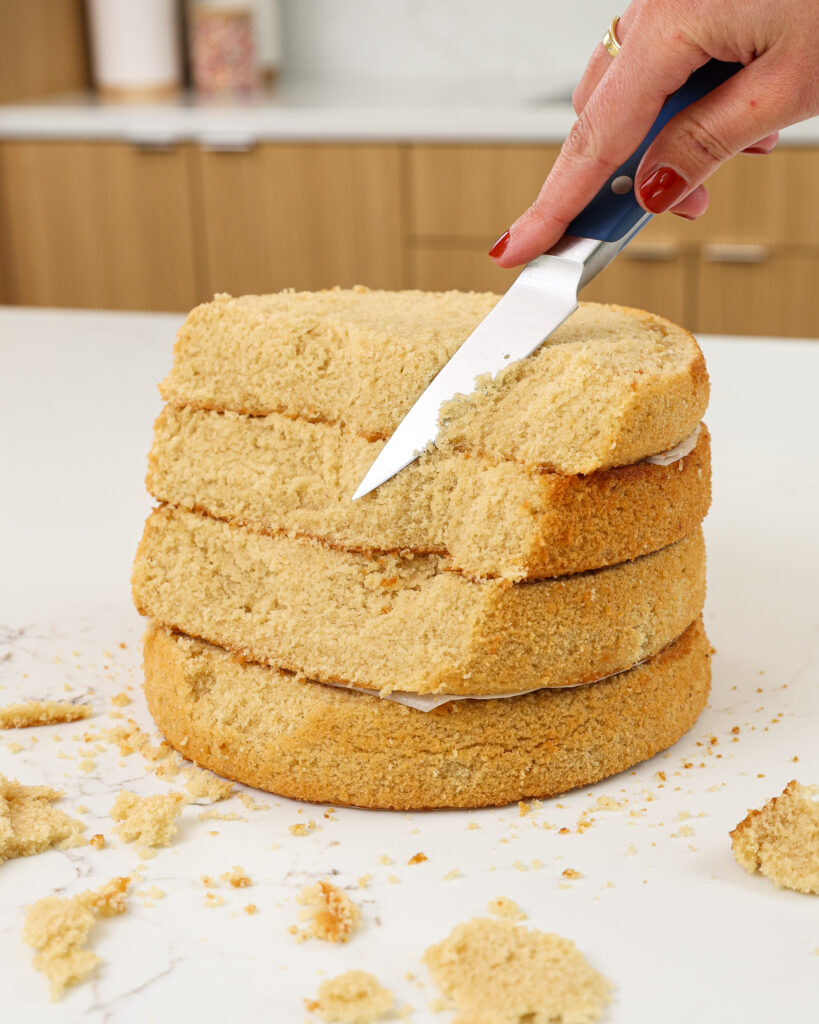
At this point you can wrap and freeze them if you’re making them in advance.
Step 4: Make the Vanilla Buttercream Frosting
While the cake layers bake and cool, make the vanilla buttercream frosting.
Mix the frosting on the lowest speed with a paddle attachment once it’s made to push out any excess air.

I also like to stir it by hand with a rubber spatula once it’s fully made. This makes the frosting silky smooth and easier to smooth onto your cake.
This frosting can also be made in advance if needed and kept in the fridge for up to a month.
Step 5: Assembling this Beach Cake
Stack and frost the cake layers on a greaseproof cake board using a dab of frosting to help stick the first cake layer to the board.
Next, cover the cake in a layer of frosting. Make sure you fully cover the cake layers, especially in the area where the gelatin ocean will be added.
Otherwise, the gelatin mixture can seep into the cake layers before it sets.

Smooth using a bench scraper, then wrap the cake tightly with thick acetate sheets.
I like to tape the sheets together (I needed two sheets to cover the entire perimeter of the cake) and trim them to be just slightly taller than the cake before wrapping them around the cake.
This makes the cake so much easier to store in fridge! Place the remaining buttercream in a large piping bag and pipe a thick border around the edge of the cutout section of the cake.
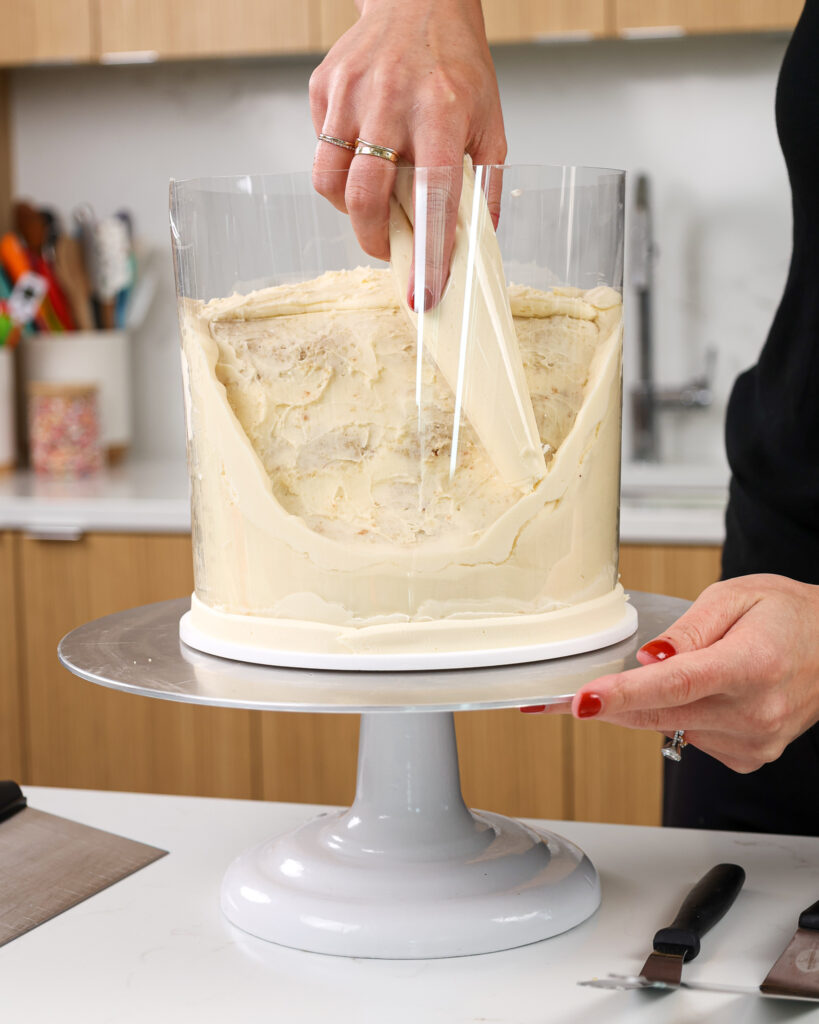
This will help prevent any leaks once you add in the gelatin ocean.
Place the cake in the fridge to chill while you work on the gelatin ocean. Leftover frosting can be left out overnight or refrigerated.
Step 6: Adding the Gelatin Ocean
While the cake chills, crumble each pan of chilled, blue ocean gradient gelatin with a fork. Set aside.
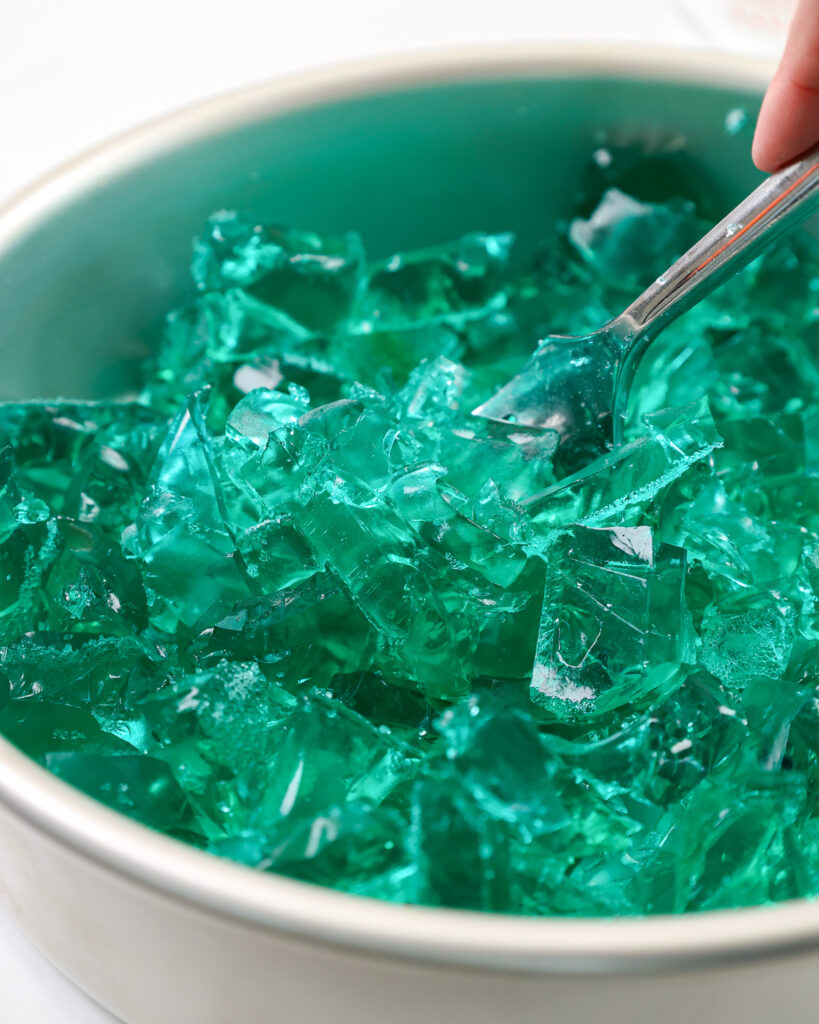
In the photos below I used 3 colors of gelatin crumbles, but the lightest shade of blue completely blended in with the ocean jelly that’s poured on top of the gelatin crumbles!
Making 2 shades will be less work and have the same effect, which is why I recommend doing that in this recipe.
Next, make the ocean gelatin and set aside. Remove the cake from the fridge and add the crumbled blue gelatin into the cut-out area.

Add the deep blue gelatin first, followed by the turquoise gelatin.
Carefully pour the ocean gelatin mixture that was just made over the gelatin crumbles inside the acetate sheet.

Set the cake in the fridge and chill overnight (at least 12 hours), or until the gelatin portion is set and firm to the touch.
Remove the cake from the fridge and carefully peel off the acetate sheet. Cover the cake portion in a second, thin layer of buttercream and avoid the jello section.
Place the cake in a shallow, rimmed pan and gently press graham cracker crumbs into frosted portion of the cake.

Add mini palm trees and other beach props to the top of the cake and use the gelatin foam to make waves. Then cut in and enjoy!
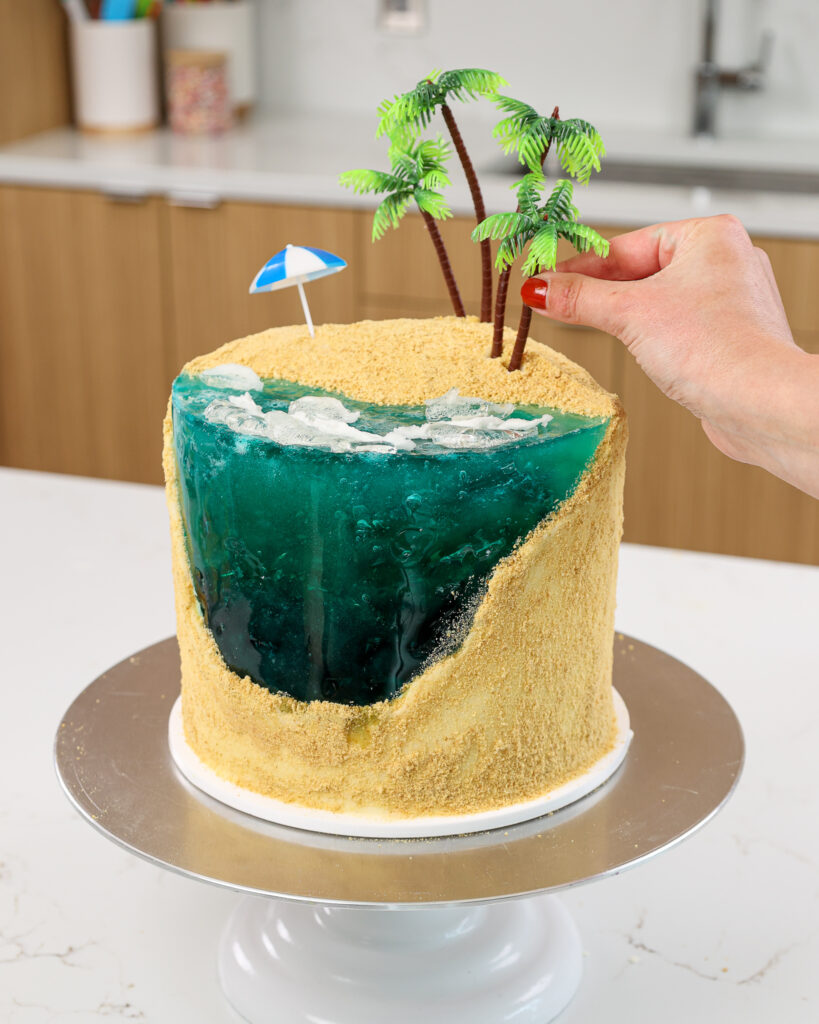
While the gelatin ocean is edible, it has a super firm texture and is mostly there for show. I recommend serving up just the cake portion of this cake!
Substitutions & Swaps – Beach Cake
Some swaps and substitutions that can be made in this recipe include:
- All-Purpose Flour– This recipe turns out best with all-purpose flour. However, you can swap in a good gluten free flour blend (like this) if needed. Just be sure to stir the batter longer than normal to help give the cake proper structure, and let the batter sit for about 20 minutes before baking it if you opt to make a gluten free version.
- Large Eggs – If you have an egg allergy you can try using a vegan egg replacer or flaxseed eggs.
- Buttermilk – You can also use full fat yogurt, sour cream, whole milk, or an alternative yogurt or milk (almond, soy, oat) if needed.
- Vegetable Oil – Use any flavorless oil in this recipe.
- Unflavored Gelatin – This recipe uses a TON of gelatin. I recommend buying a tub like this! Do not swap in flavored Jello for the unflavored gelatin in this recipe. I have not tested this recipe with agar agar, and I’m not sure it will set firm enough to make this cake design.
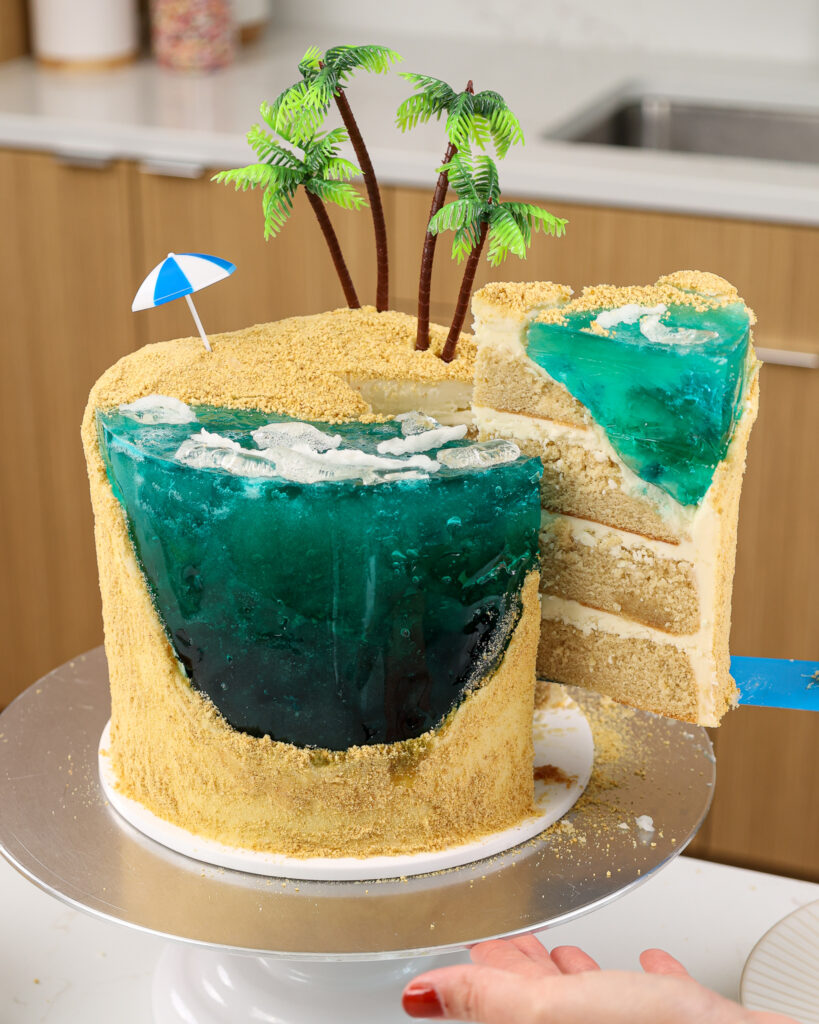
Substitutions & Swaps: Vanilla Buttercream
- Unsalted Butter – If you only have salted butter on hand, you can use it in place of the unsalted butter. Just be sure to omit the salt that this frosting recipe calls for. You can also use vegan butter in its place!
- Heavy Cream – You can use whole milk or alternative milk (soy, almond, oat) instead of heavy cream or whipping cream. This will thin the frosting out more though, so I recommend using about half the amount the recipe calls for.
Tips for Making the Best Beach Birthday Cake
- Ingredients at room temp mix together better! Set out any cold ingredients ahead of time.
- Properly measure your flour (spoon into the cup measure, then level). Or better yet, use a kitchen scale to measure your dry ingredients.
- Level your room temperature or thawed cake layers with a serrated knife to make them easier to stack.
- Chill your cake layers in the freezer for about 20 minutes before assembling the cake. It makes it so much easier to stack and frost them!
- Tightly wrap your cake with thick acetate sheets (.007″ thick) and tape them together with packaging tape. This will prevent leaks and keep the ocean gelatin in place as it sets.
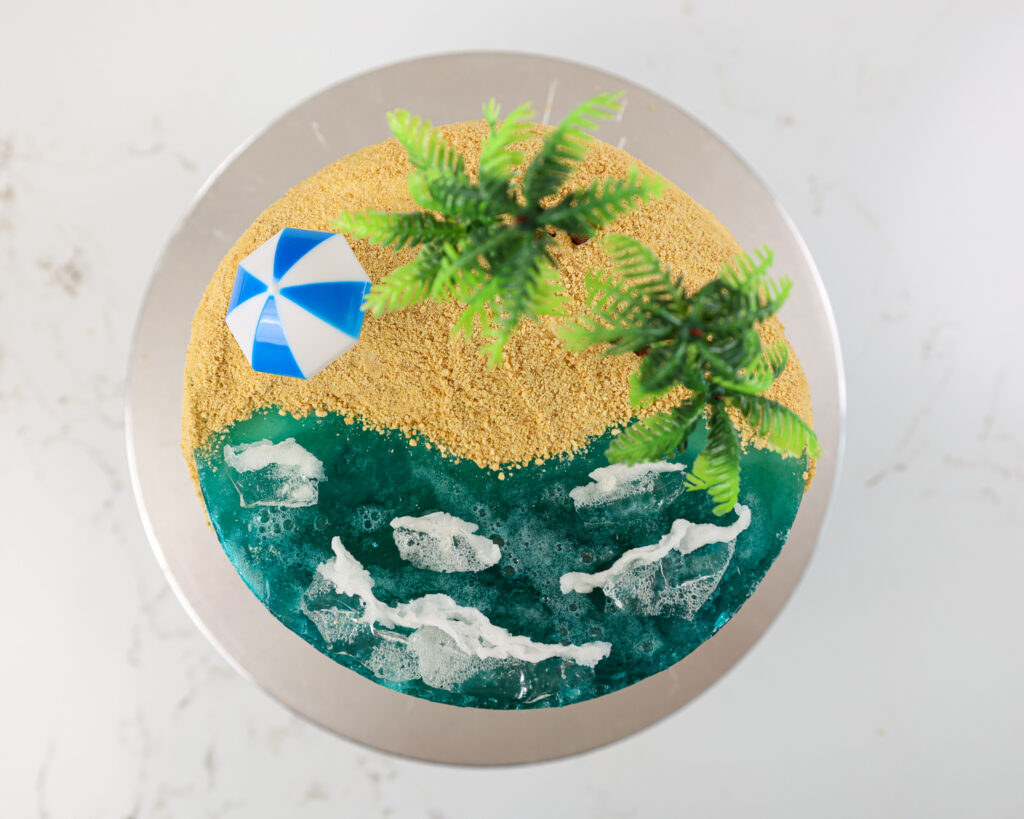
Making This Jelly Beach Cake in Advance and Storage Tips
Make your cake layers in advance and freeze them. It breaks the process up and makes it more approachable.
You can also make the frosting ahead of time or save any leftover frosting. Store it in an airtight container in the fridge for up to a month.
Just be sure to give it a good stir once it thaws to make it nice and smooth again. This cake can last in the fridge for up to a week.
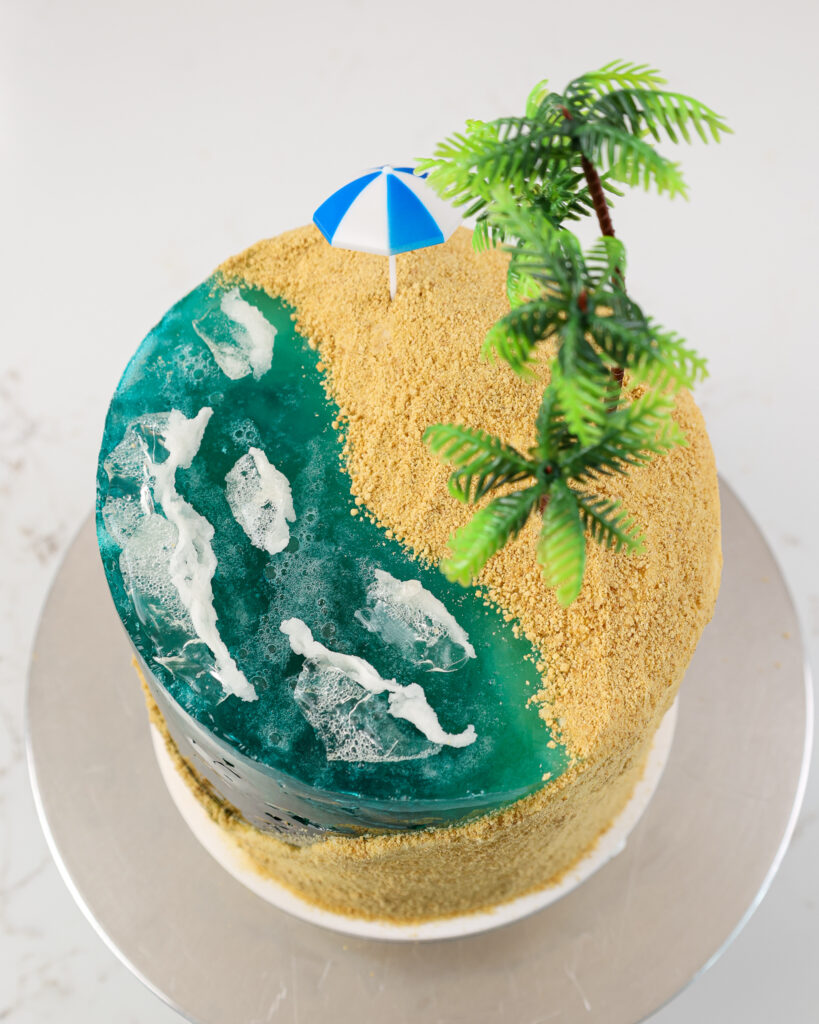
Let Me Know What You Think
If you try this beach cake recipe, I’d love to hear what you think! Please leave a rating and comment below.
Don’t forget to tag me @chelsweets and use #chelsweets on social media so I can see your amazing creations!
Other Recipes You Might Like:
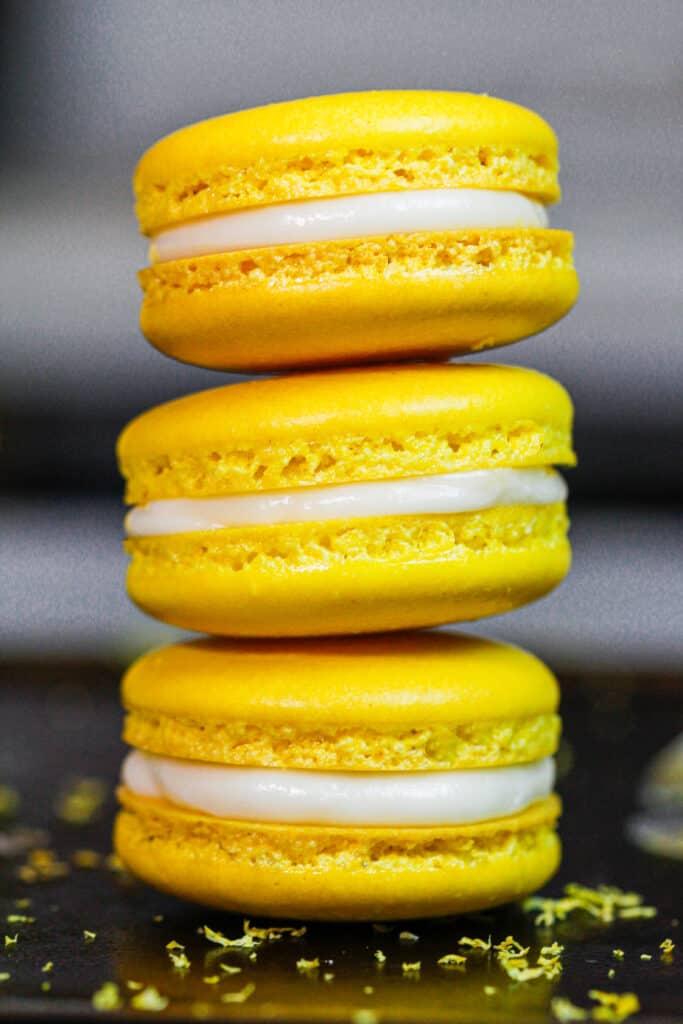



Beach Cake

This beach-inspired cake is decorated with graham cracker crumbs and a gelatin ocean!! It's the ultimate summer cake!
Ingredients
Ocean Gradient Jello
- 5 Tbsp powdered gelatin (46g), bloomed in 1 cup cold water (240g)
- 2 cups boiling water (480g)
- 1 cup granulated sugar (200g)
- 1 cup cold water (240ml)
- 1 tsp lemon extract, optional (4g)
- turquoise and blue gel food coloring
Vanilla Cake Recipe
- 3 cups all-purpose flour (375g)
- 3 cups granulated sugar (600g)
- 1 Tbsp unsweetened baking cocoa - just for color! (6g)
- 2 1/2 tsp baking powder (10g)
- 1 tsp fine salt (6g)
- 1 cup unsalted butter, room temp (226g)
- 1 cup egg whites from a carton or 7 large egg whites, room temp (235g)
- 1 1/2 cups buttermilk, room temp (360g)
- 2 Tbsp vegetable oil (30g)
- 2 tsp vanilla extract (8g)
- yellow gel food gel food coloring - optional
Vanilla Buttercream Frosting
- 2 cups unsalted butter, room temp (452g)
- 1 Tbsp vanilla extract or vanilla bean paste (12g)
- 1/2 tsp fine salt (3g)
- 7 cups powdered sugar (875g)
- 1/4 cup heavy cream or whipping cream (60g)
Ocean Jello
- 1 cup powdered gelatin (150g), bloomed in 1 1/2 cups cold water (360g)
- 1 1/2 cups boiling water (360g)
- 2 cups granulated sugar (400g)
- 1 tsp lemon extract, optional (4g)
- blue gel food coloring
Cake Decoration
- 2 cups crushed graham cracker crumbs
- 2 large, thick acetate sheets (.007" thickness)
- Packing tape
- Mini plastic palm trees
Instructions
Ocean Gradient Jello:
- Make the jello that will be used to make the gradient in the ocean first! It needs a couple hours to set. It can also be made up to a week in advance.
- Mix 5 Tbsp of gelatin and 1 cup of cold water together in a small bowl until combined. Set aside to let the gelatin absorb the water and bloom (this usually takes about 5 minutes).
- In a separate, large bowl mix together 2 cups of boiling water and 1 cup of sugar. Once the sugar is dissolved, mix in the bloomed gelatin, and whisk until combined. Then mix in 1 cup of cold water and 1 tsp of lemon extract.
- Split the mixture between 2 shallow, wide bowls or cake pans and color one turquoise and one deep blue. In the photos above I used 3 colors, but the lightest shade of blue completely blended in with the ocean jelly that's poured on top of the gelatin crumbles! I think making 2 shades will be less work and have the same effect.
- Place these in the fridge to chill and set. This usually takes about 2 hours but can vary based on the depth of the bowl you use. If making these further in advance, cover the bowls with plastic wrap.
Vanilla Cake Layers:
- Next make the vanilla cake layers. Preheat oven to 350°F / 175°C. Line four 7" or three 8" pans with parchment rounds, and grease with non-stick baking spray. I used 7" pans. You can also use this recipe to make 4, 6-inch cake layers but the bake time will be a few minutes longer and your cake will end up being a bit taller than mine. If you don't have 4 cake pans, the batter can sit at room temperature for a few hours. Bake as many layers at a time as you can at a time.
- Mix 3 cups all purpose flour, 3 cups sugar, 1 Tbsp cocoa powder, 2 1/2 tsp baking powder and 1 tsp salt together in a stand mixer with a paddle attachment or hand mixer until combined.
- Mix in 1 cup of unsalted butter slowly into the dry ingredients on a low speed. Continue to mix until no large chunks of butter remain, and the mixture looks like moist sand.
- Pour in 1 cup of egg whites and mix on low until just incorporated. Mix in 1 1/2 cups buttermilk in two installments on a low speed.
- Add in 2 Tbsp of vegetable oil, 2 tsp of vanilla extract, and a squirt of yellow food coloring. Mix at a low speed until fully incorporated. The yellow food coloring combined with the bit of cocoa powder gives these cake layers a perfect sandy color!
- Scrape down the sides of the bowl with a rubber spatula, then beat on a medium speed for about 30 seconds to make sure everything is properly mixed together.
- Divide the batter evenly between the prepared pans. I like to use a scale to make sure each pan has the same amount of batter and will bake up to be the same height.
- Bake for 33-35 minutes or until a toothpick comes out with a few moist crumbs.
- Let the pans cool for 10 minutes, then run a small offset spatula around the perimeter of the pan to separate the cake from the pan.
- Place the cake layers into the freezer for 30 minutes to accelerate the cooling process. Once the layers are fully cooled, carefully flip the pans and remove the layers.
- Use a serrated knife to level the tops of the layers, then stack the cake layers and cut them at an angle (see photo above). This will create space for the gelatin ocean! At this point you can wrap and freeze them if you're making them in advance.
- If you make these cake layers in advance and freeze them, let them thaw for about 20 minutes before assembling this cake. The cake layers should still be slightly cold to the touch, which will make it easier to assemble your cake.
Vanilla Buttercream Frosting:
- While the cake layers bake and cool, make the vanilla buttercream frosting.
- Beat 2 cups of unsalted butter on a medium speed for 30 seconds with a paddle attachment until smooth.
- Mix in 1 Tbsp of vanilla extract and 1/2 tsp salt on a low speed.
- Slowly mix in 7 cups of powdered sugar on a low speed. Add 1/4 cup of heavy cream halfway through to make the frosting easier to mix.
- Continue to mix on a low speed for a few minutes until the desired consistency is reached.
- If the frosting is too thick, add in additional cream (1 Tbsp at a time). If the frosting is too thin, add in more powdered sugar (quarter of a cup at a time).
- Cover the frosting with plastic wrap to prevent crusting and set aside.
Assembling This Beach Cake:
- Stack and frost the cake layers on a greaseproof cake board using a dab of frosting to help stick the first cake layer to the board.
- Add an even layer of buttercream between each cake layer with a large offset spatula.
- Next, cover the cake in a layer of frosting. Make sure you fully cover the cake layers, especially in the area where the gelatin ocean will be added. Otherwise, the gelatin mixture can seep into the cake layers before it sets.
- Smooth using a bench scraper, then wrap the cake tightly with thick acetate sheets. I like to tape the sheets together (I needed two sheets to cover the entire perimeter of the cake) and trim them to be just slightly taller than the cake before wrapping them around the cake. This makes the cake so much easier to store in fridge!
- Place the remaining buttercream in a large piping bag and pipe a thick border around the edge of the cutout section of the cake. This will help prevent any leaks once you add in the gelatin ocean. Place the cake in the fridge to chill while you work on the gelatin ocean.
- Leftover frosting can be left out overnight or refrigerated.
Adding the Jelly Ocean:
- While the cake chills, crumble each pan of chilled, ocean gradient jello with a fork. If you have any whiteish bubbles / foam on top of the gelatin, scoop it out into a separate bowl and place in the fridge. You can use this to make waves on top of the cake later.
- Combine 1 cup of powdered gelatin and 1 1/2 cups of cold water in a mixing bowl. Set aside to let the gelatin absorb the water and bloom (this usually takes about 5 minutes).
- Add 1 1/2 cups of boiling water and 2 cups of sugar into a large mixing bowl and whisk together until combined. Add the bloomed gelatin, lemon extract, and a small drop of blue gel food coloring. Mix until the gelatin is completely dissolved. The mixture should be a light shade of blue.
- Remove the cake from the fridge and add the crumbled blue gelatin into the cut-out area. Add the deep blue gelatin first, followed by the turquoise gelatin.
- Carefully pour the light blue gelatin mixture that was just made over the gelatin crumbles inside the acetate sheet. Set the cake in the fridge and chill overnight (at least 12 hours), or until the gelatin portion is set and firm to the touch.
- Remove the cake from the fridge and carefully peel off the acetate sheet. Cover the cake portion in a second, thin layer of buttercream and avoid the jello section.
- Place the cake in a shallow, rimmed pan and gently press graham cracker crumbs into frosted portion of the cake.
- Add mini palm trees and other beach props to the top of the cake, then cut in and enjoy!
- While the gelatin ocean is edible, it has a super firm texture and is mostly there for show. I recommend serving up just the cake portion of this cake!
Notes
Tips for Making the Best Beach Layer Cake
- Ingredients at room temp mix together better! Set out any cold ingredients ahead of time.
- Properly measure your flour (spoon into the cup measure, then level). Or better yet, use a kitchen scale to measure your dry ingredients.
- Bang your cake pans on the counter before putting it in the oven. This brings any big air bubbles that are trapped in the batter to the surface.
- Level your room temperature or thawed cake layers with a serrated knife to make them easier to stack.
- Chill your cake layers in the freezer for about 20 minutes before trimming them and assembling the cake. It makes it the process so much easier!
- Tightly wrap your cake with thick acetate sheets (.007" thick) and tape them together with packaging tape. This will prevent leaks and keep the ocean gelatin in place.
Making This Beach Cake in Advance & Storage Tips
Make your cake layers in advance and freeze them. It breaks the process up and makes it more approachable.
Make your frosting ahead of time too or save any leftover frosting! It can be stored in an airtight container in the fridge for up to a month, or in the freezer for up to 3 months. Be sure to give it a good stir once it thaws to get the consistency nice and smooth again.
A frosted cake can last in the fridge for up to a week. The buttercream locks in all the moisture, keeping the cake fresh and delicious!
Nutrition Information
Yield
20Serving Size
1Amount Per Serving Calories 808Total Fat 32gSaturated Fat 19gTrans Fat 0gUnsaturated Fat 11gCholesterol 79mgSodium 373mgCarbohydrates 121gFiber 1gSugar 101gProtein 12g

Al
Wednesday 20th of July 2022
I cannot wait to try this...thank you so much for sharing! I'll let you know how it goes!
Chelsweets
Sunday 24th of July 2022
Yay, I hope it turns out amazing Al!! Let me know how it goes :)